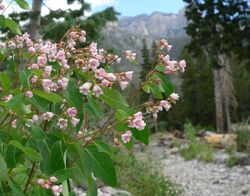Biology:Apocynum androsaemifolium
| Spreading dogbane | |
|---|---|

| |
| A. androsaemifolium var. androsaemifolium in the Spring Mountains, southern Nevada, about 2,400 m (7,900 ft) above sea level | |
| Scientific classification | |
| Kingdom: | Plantae |
| Clade: | Tracheophytes |
| Clade: | Angiosperms |
| Clade: | Eudicots |
| Clade: | Asterids |
| Order: | Gentianales |
| Family: | Apocynaceae |
| Genus: | Apocynum |
| Species: | A. androsaemifolium
|
| Binomial name | |
| Apocynum androsaemifolium | |
| Synonyms[1] | |
| |
Apocynum androsaemifolium, the fly-trap dogbane or spreading dogbane, is a flowering plant in the Gentianales order. It is common across Canada and much of the United States excepting the deep southeast.
Description
Apocynum androsaemifolium is a perennial herb with branching stems, hairs on the underside of the leaves, and no hair on the stems.[2][3][4] It grows to 20–30 centimetres (8–12 inches), exceptionally 50 cm (20 in). Milky sap[5] appears on broken stems.
Its leaves appear as pointed ovals, with entire leaf margins and alternate venation. Pairs of pink flowers bloom at the end of stalks between June and September.[5] Two seed pods 12.5–17.5 cm (5–7 in) in length contain silky-haired seeds.[5]
Taxonomy
Subspecies and varieties
Subspecies and varieties include:[1]
- Apocynum androsaemifolium subsp. androsaemifolium – E Canada, W United States
- Apocynum androsaemifolium var. griseum (Greene) Bég. & Belosersky – Ontario, British Columbia, Washington State, Oregon, Idaho, Indiana, Michigan
- Apocynum androsaemifolium var. incanum A.DC. – widespread in Canada, United States, NE Mexico
- Apocynum androsaemifolium var. intermedium Woodson – Colorado
- Apocynum androsaemifolium subsp. pumilum (A.Gray) B.Boivin – British Columbia, Washington State, Oregon, Idaho, California, Utah, Montana, Wyoming, Nevada
- Apocynum androsaemifolium var. tomentellum (Greene) B.Boivin – British Columbia, Washington State, Oregon, Idaho, California, Nevada
- Apocynum androsaemifolium var. woodsonii B.Boivin – Alberta, British Columbia, Washington State, Wyoming, Nevada, Idaho
Etymology
Apocynum androsaemifolium Linnaeus. From the Greek 'apo': far from and 'kyôn': dog, because of its toxic effects on dogs; Androsema-leaved androsaemifolium (Hypericum androsaemum).
Distribution and habitat
The plant is widespread across most of Canada , the United States (including Alaska but excluding Florida), and northeast Mexico.[5][1][6] Its native habitats include forests, woodlands, forest edges, prairies, meadows, and fields.[7] It prefers dry soils at low to medium elevations.[5]
Ecology
Animals naturally avoid the plant.[5]
Toxicity
The plant is poisonous[8] due to the cardiac glycosides and resins it contains.[9] Escalating doses usually cause vomiting and diarrhea. Other symptoms include dizziness, colour hallucinations, cold sweats, and excessive urination. In extreme cases, the heart rate may slow before fatal convulsions. Young milkweed shoots must be distinguished from those of the androsemus leaf beetle because they appear at the same time.[citation needed]
Uses
Native Americans used spreading dogbane in numerous ways. The plant was used as a medicine to treat ailments including headaches, convulsions, ear ache, heart palpitations, colds, insanity, dizziness, rheumatism, scrofula, and syphilis. The plant can also be used as a contraceptive.[10] Among the Ojibwe, the root was used as a gynecological, oral, and throat aid, as well as an analgesic for headaches and a diuretic during pregnancy. The Ojibwe also consumed the root of the plant during the medicine lodge ceremony.[11] The Forest Potawatomi made medicinal use of the roots as well, and the Prairie Potawatomi used the plant's fruits to treat heart and kidney problems.[10] The stem fibers of the plant are very strong,[11] and Native Americans used them as a thread for sewing.[12] Outside of the Americas, spreading dogbane was also used to treat heart disease in Europe during the first half of the 20th century.[13]
References
- ↑ 1.0 1.1 1.2 "Apocynum androsaemifolium". World Checklist of Selected Plant Families (WCSP). Royal Botanic Gardens, Kew. http://wcsp.science.kew.org/qsearch.do?page=quickSearch&plantName=Apocynum%2Bandrosaemifolium.
- ↑ Alan Hall, The Wild Food Guide, Holt, Rinehard, and Winston, 1976, pp. 171, 217
- ↑ Blanchan, Neltje (2002). Wild Flowers: An Aid to Knowledge of our Wild Flowers and their Insect Visitors. Project Gutenberg Literary Archive Foundation.
- ↑ Blanchan, Neltje (2005). Wild Flowers Worth Knowing. Project Gutenberg Literary Archive Foundation.
- ↑ 5.0 5.1 5.2 5.3 5.4 5.5 Spellenberg, Richard (2001). National Audubon Society Field Guide to North American Wildflowers: Western Region (rev ed.). Knopf. pp. 343–344. ISBN 978-0-375-40233-3. https://archive.org/details/nationalaudubons00spel/page/343/.
- ↑ "Apocynum androsaemifolium", County-level distribution map from the North American Plant Atlas (NAPA) (Biota of North America Program (BONAP)), 2014, http://bonap.net/MapGallery/County/Apocynum%20androsaemifolium.png
- ↑ "Lady Bird Johnson Wildflower Center - The University of Texas at Austin". https://www.wildflower.org/plants/result.php?id_plant=apan2.
- ↑ Whitney, Stephen (1985). Western Forests (The Audubon Society Nature Guides). New York: Knopf. pp. 589–90. ISBN 0-394-73127-1. https://archive.org/details/westernforests00whit/page/590.
- ↑ Elias, Thomas S.; Dykeman, Peter A. (2009). Edible Wild Plants: A North American Field Guide to Over 200 Natural Foods. New York: Sterling. pp. 267. ISBN 978-1-4027-6715-9. OCLC 244766414. https://www.worldcat.org/oclc/244766414.
- ↑ 10.0 10.1 "Apocynum androsaemifolium - Spreading Dogbane". https://eflora.neocities.org/Apocynum%20androsaemifolium.html.
- ↑ 11.0 11.1 "BRIT - Native American Ethnobotany Database". http://naeb.brit.org/uses/search/?string=Ojibwa&page=2.
- ↑ Fagan, Damian (2019). Wildflowers of Oregon: A Field Guide to Over 400 Wildflowers, Trees, and Shrubs of the Coast, Cascades, and High Desert. Guilford, CT: FalconGuides. pp. 21. ISBN 978-1-4930-3633-2. OCLC 1073035766. https://www.worldcat.org/oclc/1073035766.
- ↑ Xie, Wenyan; Zhang, Xiaoying; Wang, Tian; Hu, Jianjun (7 May 2012). "Botany, traditional uses, phytochemistry and pharmacology of Apocynum venetum L. (Luobuma): A review". Journal of Ethnopharmacology 141 (1): 1–8. doi:10.1016/j.jep.2012.02.003. PMID 22421379. https://www.sciencedirect.com/science/article/pii/S0378874112000712. Retrieved 28 March 2021.
External links
- "Apocynum androsaemifolium". Natural Resources Conservation Service PLANTS Database. USDA. https://plants.usda.gov/core/profile?symbol=APAN2.
- "Apocynum androsaemifolium". http://www.pfaf.org/user/Plant.aspx?LatinName=Apocynum+androsaemifolium.
- CalFlora Database, University of California: Apocynum androsaemifolium
- Minnesota Wildflowers
- Montana Plant Life
- Plants of Wisconsin
- Jepson Manual Treatment
Wikidata ☰ Q2858412 entry
 |

